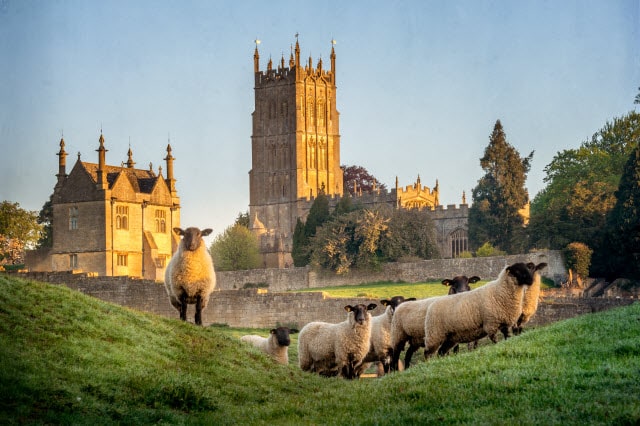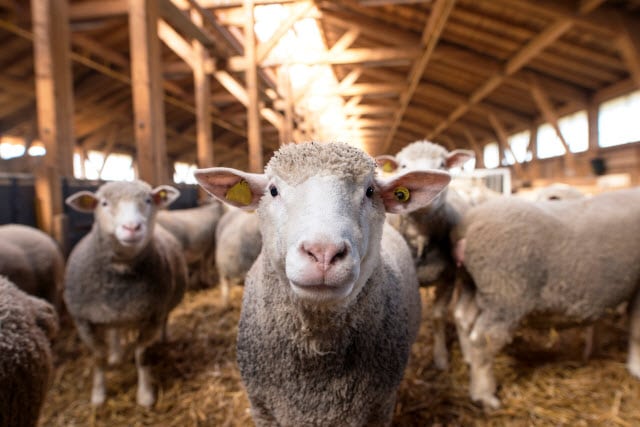Did you know that there are over a billion sheep worldwide? That’s just one of the 67 fascinating facts about sheep I’ve gathered together in this article filled with quirky and interesting sheep facts and trivia. Read on to find out all about these wonderful farm animals that have been living closely with humans for thousands of years.
I encourage you to scroll through the entire article and read all of the sheep facts I’ve put together here, but in case you are interested in a particular area, you can skip ahead to one of these sections by clicking the links below:
Now let’s get into some fascinating sheep facts and trivia, starting with:
Historical Facts About Sheep
Also known by the scientific name Ovis aries, the sheep is one of the first animal species domesticated by humans for agriculture.

Here are some little-known facts about sheep dating back millennia ago.
- Some evidence suggests that sheep were domesticated 10,000 years ago in Central Asia. However, they were discovered long before as since there are several biblical references to sheep, especially in the Old Testament.
- It was in 3,500 BC that people learned how to spin wool.
- In ancient Egypt, sheep were believed to be sacred. Some were mummified when they died.
- Babylon was also known as the Land of Wool. People in Babylon began wearing clothes made of wool in 4,000 BC.
- The wool industry was developed around 6,000 BC in Iran and other Persian countries. Sheep breeding and production is one of the oldest organized industries.
- Columbus brought sheep to Cuba in 1493 during his second voyage to the New World.
- In the early 1500s, Cortes introduced sheep to Mexico and Western America. The sheep he brought were believed to be the offspring of Columbus’ sheep. It’s believed they were descendants of the Navajo Churro, the oldest breed of sheep in the US.
- In the 1600s, England declared it illegal to import sheep to America to gain supremacy in wool clothing production. Violation of the law was punishable by cutting off the person’s hand.
- Nonetheless, colonists smuggled sheep to America, and by 1664, there were about 10,000 sheep in the American colonies.
- In the late 1600s, America began exporting wool goods, which outraged England. Along with the Stamp Act, this led to the American Revolutionary War.
- American presidents George Washington, Thomas Jefferson, James Madison, and Woodrow Wilson were known to have been fond of raising sheep.
Information & Facts About What Sheep Look Like
It may surprise you to learn that sheep are close relatives of goats, antelopes, cattle, and even muskoxen! Sheep share some similar characteristics with these animals, but they also possess a few features that make them distinct.

Let’s take a closer look at some facts about what sheep look like and how their appearance differs from that of other species:
- Domestic sheep have crimped coats which are wool and short tails (the tails are long at birth, but most shepherds dock the tails of sheep).
- The color of the coat of wild sheep is usually in brown hues, while domestic sheep have pure white to dark brown coats. Some have pigmented spots.
- Sheep are ruminant mammals, which means that their stomachs have four chambers. The first chamber, called the rumen, is the largest one. The second chamber is the reticulum, the third one is the omasum, and the last one is the abomasum.
- Sheep are even-toed ungulates. Like cows, buffalos, and goats, sheep have cloven hooves or hooves split into two toes.
- Sheep are herbivores and eat seeds, grass, and plants. Unlike goats, sheep have a groove that divides their upper lip, called a philtrum.
- Sheep have rectangular pupils. This gives them a wider field of vision estimated within 270 to 320 degrees. As prey animals, having rectangular pupils allow sheep to detect motion better without turning their heads, so they can immediately flee when they spot predators.
- Horns commonly grow in male sheep or rams, but there are some sheep breeds (like the Jacob) in which both males and females have horns.
- Wild sheep are larger than domesticated sheep species. The Argali is the largest sheep species, which can grow up to 1.2 meters tall. They also have longer horns for defending themselves against predators.
- Ewes (female sheep) typically weigh between 45 to 100 kilograms, while rams (male sheep) weigh between 45 to 160 kilograms.
- Adult sheep have approximately 32 teeth.
Facts About Sheep Behavior
Sheep are generally known for their gentle temperament, but they also have some surprising tendencies.

In this section we’ll take a closer look at some information about how sheep tend to behave (and why they behave that way):
- Sheep have a strong flocking behavior and are less independent than goats.
- A group of sheep is called a flock, herd, or mob.
- Castrated sheep are called wethers.
- “Gummers” is the name for sheep that lost all of their teeth due to old age.
- Isolated sheep or those separated from their flock show signs of depression by hanging their heads low or avoiding positive actions.
- Sheep have an amazing memory. They can recognize up to 50 faces of other sheep and remember them for up to two years. They can also recognize human faces.
- Sheep can also recognize different facial expressions, preferring a smile to a frown.
- Like other animals, sheep use vocalizations to communicate various emotions such as fear, anger, happiness, and boredom.
- Rams make a rumbling sound during courtship. Rut, or sheep mating season, happens in autumn.
- The gestational period of ewes is about five months. Ewes give birth to one to two offspring at a time.
- Newborn sheep can walk within minutes after they are born, but are dependent on their mother’s milk until the 6th month of age.
- When ill, sheep can self-medicate by eating specific plants that will help cure them.
- Sheep prefer drinking from running water instead of water from a trough.
Sheep Breed Information & Facts
Over a thousand sheep breeds exist around the world. Breeds are categorized in a number of different ways. These include: wool type, face color, tail length, the topography where sheep live, or whether or not they have horns.

Let’s take a look at some of these differences, and why they exist:
- There are over a thousand sheep breeds recognized worldwide. In the US, there are over 60 sheep breeds.
- The Merino, Romney, Cotswold, and Rambouillet breeds are a few known to be good providers of wool.
- The Dorper, Hampshire, Southdown, Suffolk, and Cheviot are breeds raised for meat production.
- For dairy production, some of the most popular sheep breeds are the East Friesian, Finnish Landrace, and Polypay.
- The largest wild sheep breed is the Argali (Ovis ammon), which is native to Central Asia. Mature rams reach a height of 125 cm and a weight of over 140 kilograms.
- The smallest breed of sheep is the Ouessant. A fully grown ram stands at about 45 cm at the shoulder.
- Countries with the largest sheep population are China, Australia, India, Nigeria, and Sudan.
Facts About the Products Sheep Produce
Sheep are raised for agricultural purposes because they are sources of many products that can be useful to humans. Not only are sheep raised for meat and wool, but there are a number of other sought-after products that sheep produce for us.

Let’s take a closer look at some of them:
- Wool is the most popular material from sheep. It is used for clothing and bedding, as well as making furniture and insulating houses.
- Wool can still make you warm, even when it is damp.
- Wool is anti-microbial and fire and wrinkle-resistant. It is also biodegradable.
- Wool garments last longer than those made from cotton or silk. Wool breaks after 20,000 bends, while cotton breaks after just 3,000 bends.
- One sheep can produce up to 30 pounds of wool per year.
- Lanolin or wool wax is a by-product of sheep wool. It is a common ingredient in cosmetics, such as lipstick, mascara, and shampoo. Manufacturers also use lanolin to produce tape, printing ink, and motor oil.
- Sheep’s milk is high in nutritional substances like protein, calcium, iron, minerals such as magnesium and zinc, and vitamins such as Vitamin B6, Vitamin B12, and Vitamin D. It is also rich in amino acids and linoleic acids.
- Sheep’s milk has smaller fat globules which make it easy to digest.
- Most Cheese makers prefer sheep’s milk, as it is the creamiest among cow’s and goat’s milk. Some popular cheeses made from sheep’s milk include: Feta, Ricotta, Roquefort, Manchego, and Pecorino Romano.
- Sheep’s milk is higher in protein, making them a healthier alternative to cow’s and goat’s milk, especially for health and fitness enthusiasts.
- Sheep’s milk is naturally alkaline. Alkaline-rich food helps the body absorb nutrients faster, helping boost immunity.
- Lamb is the meat from a sheep under 12 months old, while mutton is meat from a sheep that is over the age of one year.
- Cuts of lamb are more tender and milder in flavor than mutton.
- Lamb is not just tasty, but it is also rich in protein, vitamins, and minerals.
- Sheepskin (also called lambskin or shearling) is the hide of a sheep. It undergoes a tanning process to turn it into soft leather.
- Sheepskin leather is an excellent material for wallets, bags, shoes, belts, jackets, and upholstery for couches and car seat covers.
- Because sheep are intelligent, docile, and social animals, they make an attractive model for scientists in several types of research.
- Sheep regularly participate in agricultural and biomedical studies. Sheep blood offers an ideal climate for culturing bacteria and stem cell research.
- Wool proteins are used to create wound dressings, bone graft implants, and medical sutures with the aid of nanotechnology.
Facts About Some Famous Sheep
Believe it or not there have been numerous sheep throughout history that are famous for one reason or another.

Here are a few you may have heard of (or may want to learn more about):
- Dolly the sheep was the first animal to be cloned from an adult cell in July 1996 by scientists at the Roslin Institute. The team of scientists was led by Sir Ian Wilmut.
- Chris the Sheep, a Merino, was known for holding the world record for the heaviest fleece. He was spotted in Canberra in 2015, and 41.1 kilograms of fleece was shorn from his body. He died in 2019 and was believed to reach the age of 9 years old. Before him, Shrek the Sheep, also a Merino, which had a 60-pound coat of fleece, held the title for 11 years.
- Lance Corporal Derby XXX from the United Kingdom is the highest-ranking sheep in the British Armed Forces. He was promoted on September 1, 2015, at the Dale Barracks in Chester. A few months after his promotion, the three-year-old Swaledale ram passed away due to a bacterial infection.
- Based on the Guinness World Records, the oldest living sheep is Grandma, also known as Ewe #23. Grandma is a Horned Dorset and is 23 years old.
- Other sheep who held the world record for the oldest sheep were Lucky, who died in November 2009 at age 23 years old, and Methuselina, a Scottish blackface, who reached the age of 25 years and 11 months before passing away in 2012.
- Montauciel was the first mammal to fly on a hot-air balloon in 1783, thanks to the Montgolfier brothers.
- The world’s most expensive sheep is Double Diamond, a Texel lamb, which was sold for around $490,000 in an auction in Scotland.

